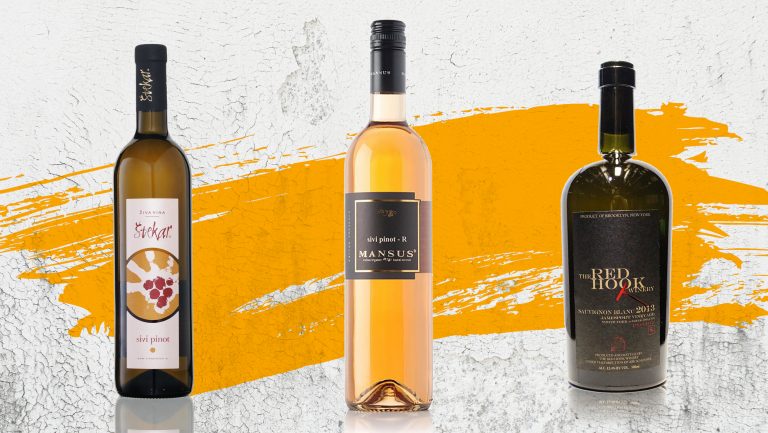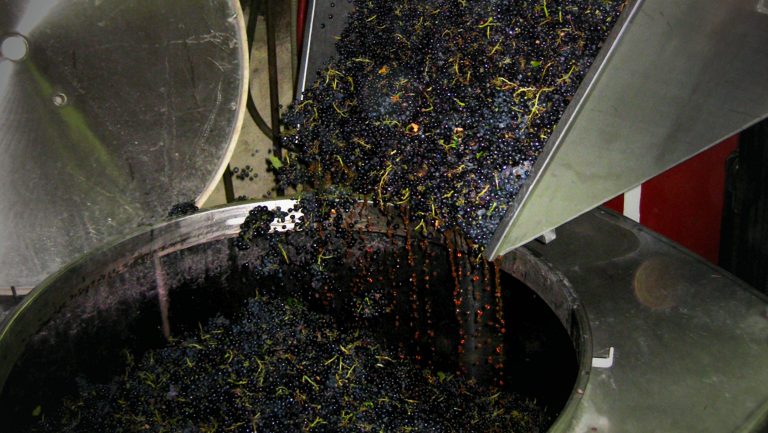“In this one, you get the black tea taste,” says Patrick Cournot, the owner of Ruffian wine bar, as he pours an amber-hued glass of Georgian single-varietal Rkatsiteli for a customer. “But in this one”—he pours a coppery pink Pinot Gris from Štekar winery in Slovenia—“it’s a black tea explosion!”
Like many contemporary wine bars, Ruffian, which opened in 2016 in New York City’s East Village, has a proud fondness for these orange wines. “It could be easy to dismiss them as a fad,” says Alexis Percival, the co-beverage director and one of Cournot’s partners, but she and Cournot decidedly don’t. The bar’s list runs to more than 30 orange bottles, in addition to a daily, changing by-the-glass lineup that ranges from entry-level glasses for the orange-wine novice, like Mansus’ Sivi Pinot from Slovenia, which Percival likens to a “rosé with backbone,” to unfiltered, unsulfured offerings that are as full and funky as any natural-wine devotee could desire. The surface of the bar itself is pale off-white rather than dark wood, the better to flatter the unusual range of colors of the wines.
Those colors not only give the wines their sobriquet and Instagrammable eye appeal but are intrinsic to the process that makes them unique. It starts with white grapes, but unlike white wines, in which the skins are separated from the juice right away, orange-wine juices are allowed to macerate in contact with the skins for weeks or months. Water- and alcohol-soluble compounds in the skins are thus extracted and dissolved into the juice—compounds that are deliberately, or incidentally, excluded from white wines.

Don’t miss the latest drinks industry news and insights. Sign up for our award-winning newsletters and get insider intel, resources, and trends delivered to your inbox every week.
Most significantly, grape skins contain numerous compounds classified as phenolics that contribute in various ways to wine’s color, texture, aroma, and taste. During aging, the phenolics react with each other and with other molecules, growing larger and forming components that give the finished wine its character. These phenolic products are most familiarly encountered in red wine in the form of the pigments and tannins.
The white grapes from which orange wines are made lack anthocyanins, the phenolics that give red wines their color, but other phenolic reactions take place during aging. Roger Boulton, PhD, a wine scientist and the Stephen Sinclair Scott Endowed Chair in Enology in the Department of Chemical Engineering at U.C. Davis, who has written extensively on wine color, says that over time, small phenolic molecules join up, probably in pairs or trios, into complexes that give orange wines their range of hues. “If you look for an orange pigment, you won’t find it,” he says. “You find some red ones, which are very dilute, mixed in with some amber-brown ones. The color comes from two flavonoid molecules, or a flavonoid and a nonflavonoid [phenol], getting together and forming something that’s a little pink. And chlorophyll interacts with some other things and gives you a golden color, then you get to amber, and then you get to dark amber.”
The presence of these two color families in a glass of skin-fermented wine—as well as, in the case of grapes like Pinot Gris, a little anthocyanin pigment extracted from the pink skin—is what’s responsible for the range of yellow, orange, and rosy colors in these wines.
Skin contact also leads to the development of tannins—not to the same extent as is typical in red wines, because anthocyanins also play a role in tannin creation, but unmistakably giving rise to the “black tea” and other astringent tasting notes characteristic of orange wines.
Orange wines thus have some of the mouthfeel and bitterness of reds, but with aromatic character from the white grapes that are used. “The variation among these wines,” says Boulton, “is the perfect example of what happens when you do the same thing—which is practically nothing—in different locations with different grapes.”
Christopher Nicolson, who makes orange wines at Red Hook Winery in Brooklyn, New York, values the production technique as “one of the spectrum of possible ways to express the fruit. The range of aromatics are not narrow. One skin-fermented Sauvignon Blanc might smell of conifers, mint, and licorice, and it may be dark amber in color and austerely tannic in the mouth. Another skin-fermented Sauvignon Blanc might smell of roasted sugar and citrus peel, it may be light yellow, and only mildly tannic.”

“Much of the chemistry of the coloration is known, but we’re still struggling to understand which combinations of molecules give a product its character,” says Boulton. “The weakest part of all wine grape chemistry is flavor molecules.”
Skin-contact wines are widely considered at their best when paired with food. At Ruffian, where sweet and piquant ingredients like fennel, curry, and pickled vegetables spice up the menu of shareable plates, “orange wines function really well,” Percival says. “They are bright enough to pair with vegetables and fish, and substantial enough for meat dishes. While many restaurants try to pair for contrast—like using Riesling’s acidity, residual sugar, and fruit to contrast with spices—this gives us a way to create symmetrical pairings too.”
Boulton points out that orange wines predate white wines and that their distinctive character evolved organically as “part of a culture of wine and food. In a relatively cool, remote region like Georgia, where there’s a reliance on meat, what kinds of wines would go with that? Some would be more acidic, and some would be more tannic than a normal quaffing wine.”
“More than anything else, these [orange wines] are typically fun wines,” says Percival. “They don’t need to eclipse any other styles of wine, but they are good enough that … people should be exposed to them.”

Dispatch
Sign up for our award-winning newsletter
Don’t miss the latest drinks industry news and insights—delivered to your inbox every week.
Paul Adams is the senior science research editor at Cook’s Illustrated. He lives in New York City, where he writes about food and drinks.







